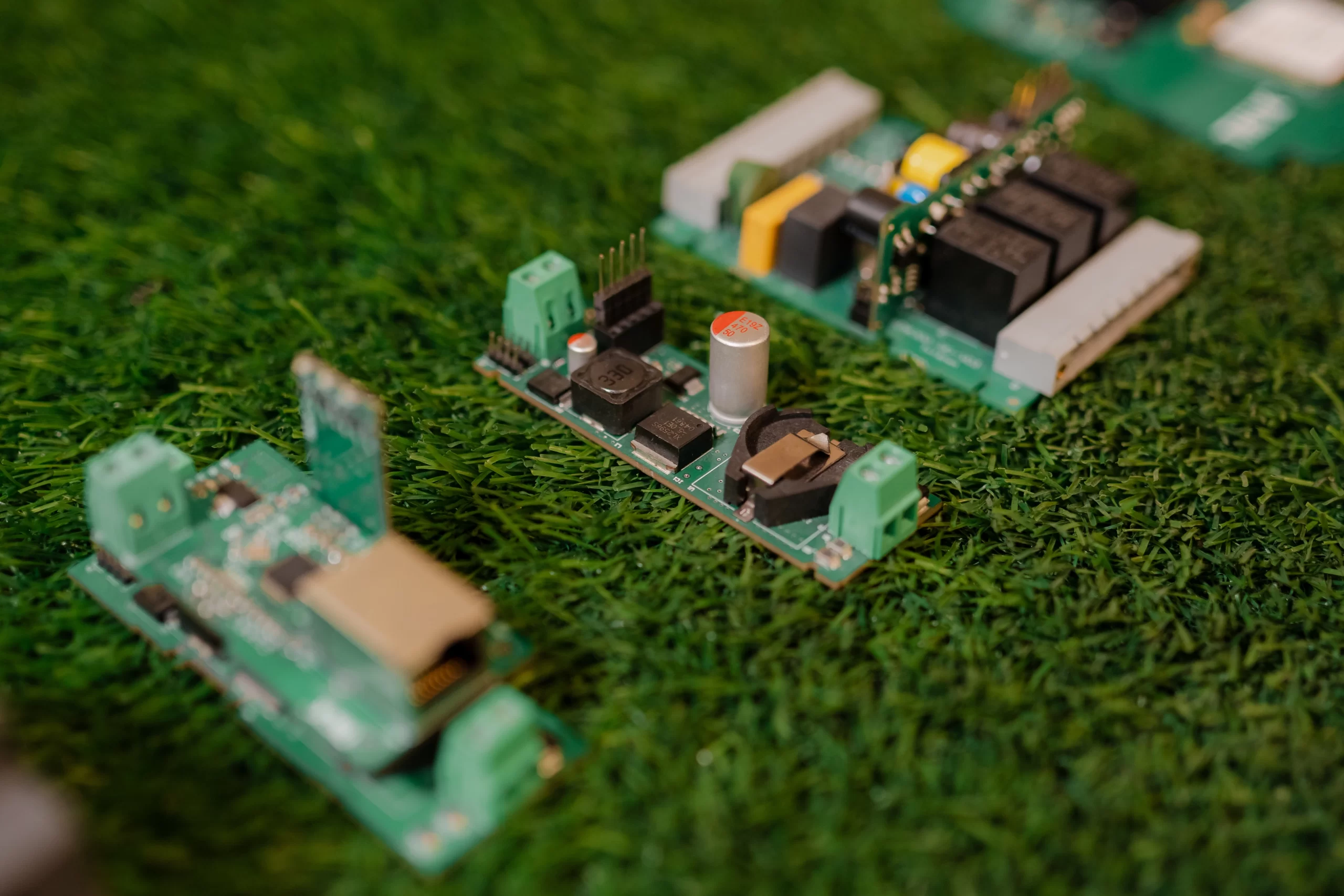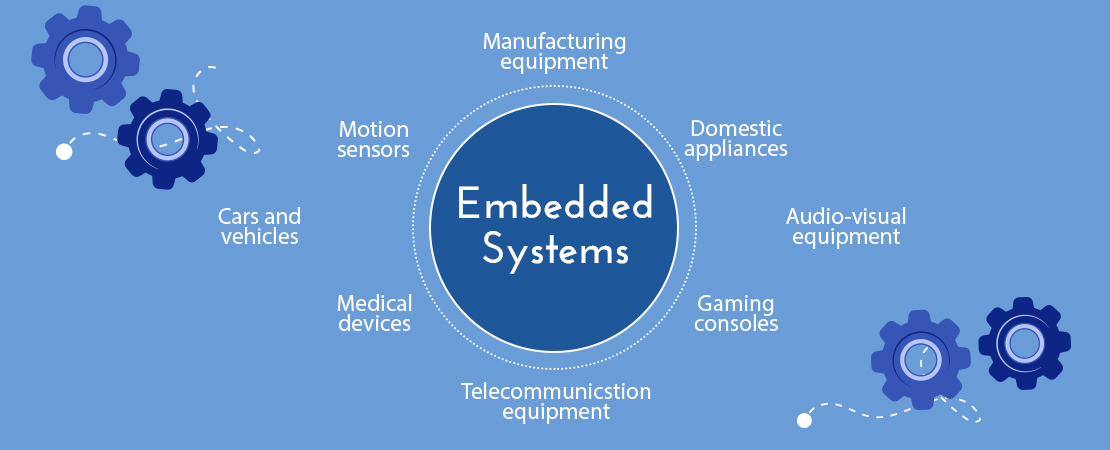What Are Embedded Systems?
An embedded system is a special type of computer system that is made to do a specific task or a small number of tasks. Unlike general-purpose computers like laptops or smartphones, embedded systems are not meant to do many things. They are designed to do their own job very well, like controlling the temperature of a microwave or managing a car’s engine.
These systems usually contain a main part called a microcontroller or microprocessor. This part acts as the brain and handles instructions and data. Besides the processor, embedded systems also include other important hardware components. These can be memory, input/output interfaces, communication ports, and a power supply. All these parts work together, allowing the embedded system to interact with its surroundings, take in input, process information, and give out results.
Embedded System Trends
Embedded systems trends are constantly evolving with the rapid progress of technology. One significant trend that has been reshaping embedded systems is the integration of artificial intelligence (AI). AI has been instrumental in enhancing the capabilities and efficiency of embedded systems, enabling them to perform more complex tasks effectively.
Another notable trend is the increasing emphasis on connectivity through wireless networks and network connections. This advancement facilitates seamless data exchange between embedded devices, leading to improved communication and functionality.
There is a growing demand for low power consumption in embedded systems, driven by the widespread use of mobile devices and Internet of Things (IoT) applications. Optimizing energy efficiency has become a key focus in developing embedded systems to prolong battery life and reduce environmental impact.
These emerging trends in embedded systems underscore the importance of achieving enhanced performance, connectivity, and energy efficiency. As technology continues to advance, we can expect further innovations that will shape the future landscape of embedded systems and drive progress in various industries.

Types of Embedded Systems
Embedded systems can be grouped by how well they perform, what functions they need, or both. It’s important to know these groups to pick the best embedded system for a specific job. Let’s explore some common types of embedded systems.
Performance and Functionality Requirements-Based Classification
This classification sorts embedded systems by how well they can meet certain needs. These needs include things like response time, processing power, and the difficulty of tasks the system can manage. For example, some tasks need a very fast response. This is true for control systems used in machines or medical devices. These systems have to work right away to keep things safe and accurate.
On the other hand, some applications care more about using less power rather than being super fast. This is often found in wearable devices or remote sensors that check the environment. For these devices, using energy well is crucial so they can work longer.
Standalone Embedded Systems
These systems operate independently, not requiring any host system for functionality. They are self-sufficient and perform specific tasks without human intervention. Examples include household appliances, digital cameras, and microwave ovens. Typically with limited memory, they run on low power to function efficiently. Standalone devices are designed for simplicity and specific functions, such as data management in digital watches or user interfaces in mobile phones. Despite their small scale, they provide essential services in various everyday devices.
Real-Time Embedded Systems
In embedded systems, working in real-time is very important for tasks that need exact timing and fast reactions. Real-time embedded systems are built to follow strict deadlines for processing data and creating outputs. Their quick responses are crucial in many areas like:
- Industrial control systems: They help manage machines in factories and plants.
- Medical devices: These include tools that watch vital signs, control infusion pumps, and keep critical medical equipment safe.
- Automotive systems: They manage engine tasks, control airbag deployment, and help with advanced driver-assistance features.
Network Embedded Systems
Networked embedded systems use network connections to talk to and work with other systems or devices. They use communication methods like Ethernet, Wi-Fi, or Bluetooth to share information and coordinate activities. You can see examples of networked embedded systems in:
- Home security systems: These connect sensors, alarms, and cameras to a main hub, allowing for remote monitoring and control.
- Traffic control systems: These manage traffic lights and help improve traffic flow.
- Industrial automation systems: These allow machines, robots, and control systems in a factory to communicate and exchange data.
Mobile Embedded Systems
Mobile Embedded Systems encompass devices like smartphones and tablets, integrating advanced functionalities in compact form factors. These systems are vital components of the Internet of Things (IoT) landscape, enabling seamless connectivity and communication. From mobile phones to electric vehicles, these systems efficiently manage tasks with low power consumption. They often feature wireless communication ports and are pivotal in modern consumer electronics. Mobile Embedded Systems illustrate the convergence of hardware and software in portable devices, embodying the essence of embedded systems in everyday life.
Microcontroller Performance-Based Classification
Embedded systems can be grouped by the power and complexity of the microcontroller inside them. This way of grouping helps to understand what the system can do.
Small-Scale Embedded Systems
Small-scale embedded systems are designed using microcontrollers with limited processing power, memory, and peripherals. These systems are typically employed in applications with simple logic and control requirements, such as controlling basic appliances or small electronic devices.
Feature | Description |
Processing Power | 8-bit or 16-bit microcontrollers |
Memory | Limited, typically in kilobytes |
Peripherals | Few and basic, such as timers, counters, and simple communication interfaces |
Applications | Simple appliances, basic control systems, toys |
Medium-Scale Embedded Systems
Medium-Scale Embedded Systems represent a balance between complexity and simplicity, falling between small-scale and sophisticated systems. These systems typically involve a moderate level of hardware components and software tools to perform specific tasks efficiently. Examples include industrial automation systems, household appliances, and control systems for small to mid-sized equipment. They require a higher level of processing power and memory compared to small-scale systems but are not as advanced as sophisticated embedded systems like autonomous vehicles or complex medical devices. These systems cater to a wide range of applications, striking a middle ground in terms of functionality and performance.
Sophisticated Embedded Systems
Sophisticated embedded systems are very complex and showcase how far microcontroller technology has come. They use powerful 32-bit or 64-bit microcontrollers. These microcontrollers provide fast processing, large memory, and many available tools. These advanced systems are essential for new technologies, like self-driving cars, advanced medical imaging, and complex industrial automation.
These uses require strong processing power, smart algorithms, and the ability to handle large amounts of data quickly. As technology grows, we can expect even more advanced embedded systems, expanding what is possible in many areas.
Conclusion
In conclusion, it is important to understand the different kinds of embedded systems in today’s tech-focused world. There are various types such as standalone, real-time, network, mobile, and microcontroller-based systems. Each one has a key role in various uses. Embedded systems are everywhere. They improve how well many devices work that we use every day. They help run everything from household appliances to industrial machines, making our lives easier. By learning more about embedded systems, we can discover new ideas and opportunities for future tech improvements. If you want to learn more about this interesting area, check out our frequently asked questions section for extra information.
FAQ’s
How Do Embedded Systems Impact Our Daily Lives?
Embedded systems are everywhere. They quietly change our lives by being part of many things. You can find them in home security systems, medical devices, smart appliances, and cars. They make our lives safer, easier, and more efficient in many ways.
Can Embedded Systems Be Upgraded or Modified After Deployment?
Upgrading embedded systems after they have been installed can be hard because of hardware limitations. Some systems can be updated with software to improve how they work. However, making big changes or adding new features usually needs hardware adjustments or a full replacement of the system.
Do we use Java in embedded system programming?
C and C++ are popular programming languages. However, Java is used in embedded system programming too. It comes with special versions like Embedded Java. Choosing a programming language depends on how complex the application is and the needs of the embedded system.
